Drug Catalog - Product Detail
LAMOTRIGINE XR 25MG TB 30
| NDC | Mfr | Size | Str | Form |
|---|---|---|---|---|
| 65162-0949-03 | AMNEAL PHARMACEUTICALS | 30 | 25MG | TABLET |
PACKAGE FILES
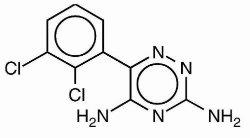

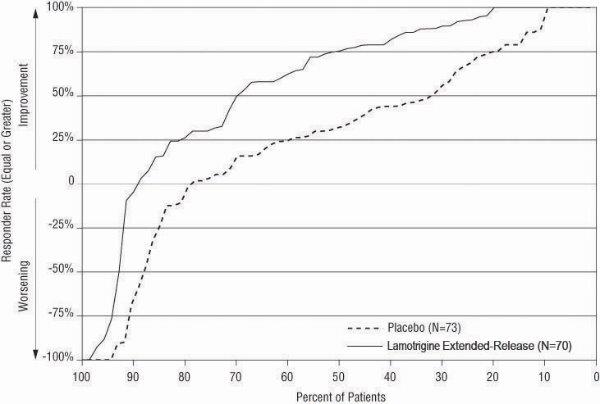
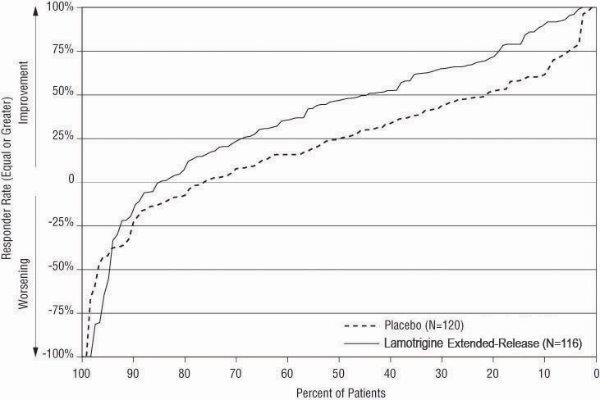
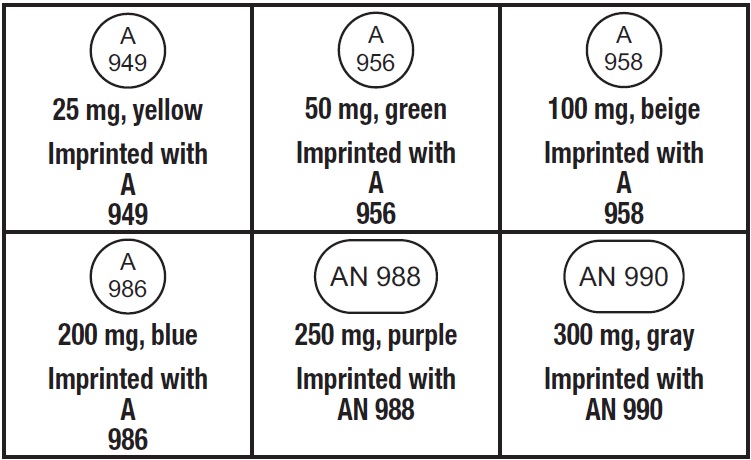
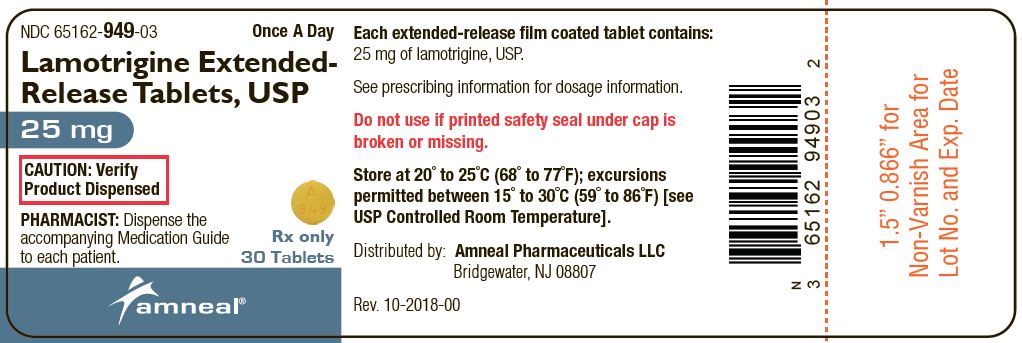
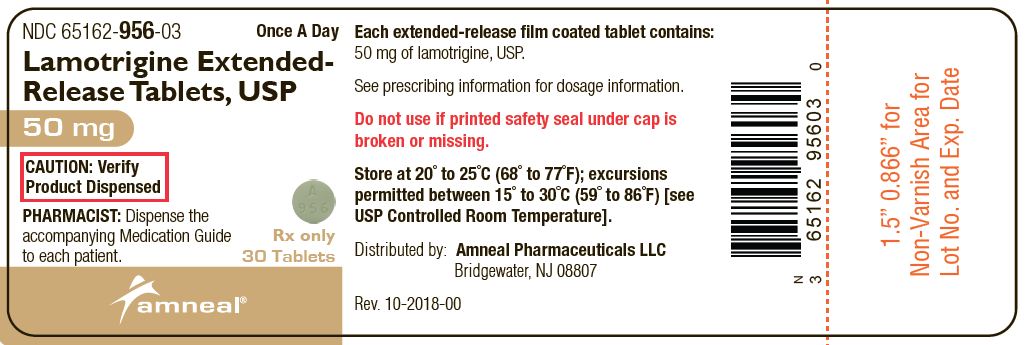

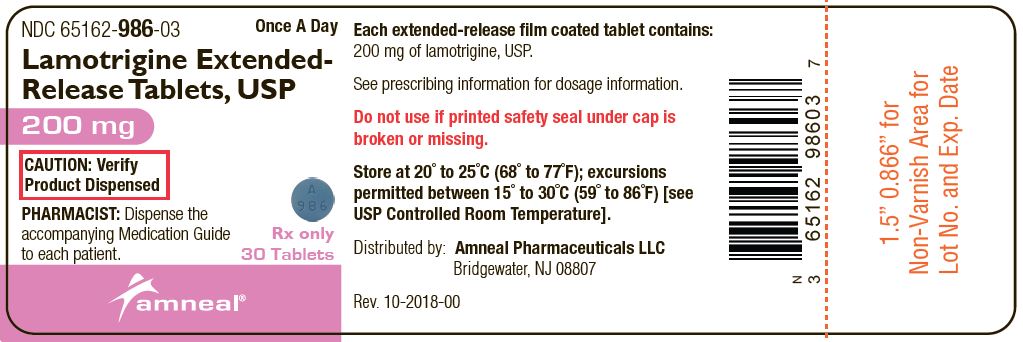
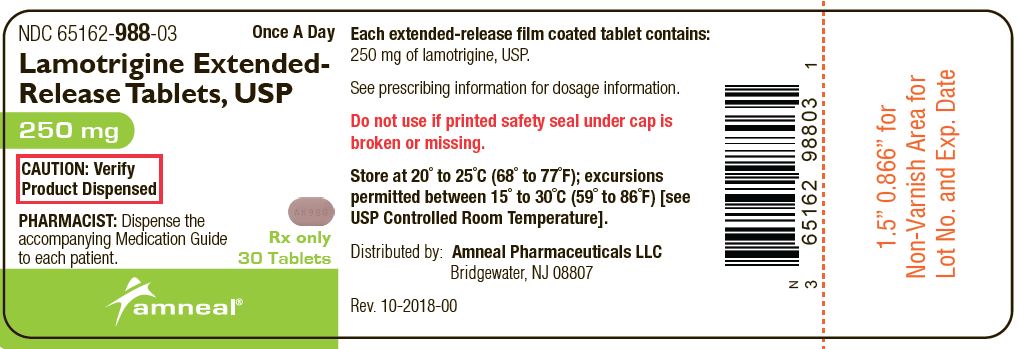
Generic Name
LAMOTRIGINE
Substance Name
LAMOTRIGINE
Product Type
HUMAN PRESCRIPTION DRUG
Route
ORAL
Application Number
ANDA207497
Description
11 DESCRIPTION Lamotrigine, USP, an AED of the phenyltriazine class, is chemically unrelated to existing AEDs. Lamotrigine's chemical name is 3,5-diamino-6-(2,3-dichlorophenyl)- as -triazine, its molecular formula is C 9 H 7 N 5 Cl 2 , and its molecular weight is 256.09. Lamotrigine USP, is a white to pale cream-colored powder and has a pK a of 5.7. Lamotrigine USP, is very slightly soluble in water (0.17 mg/mL at 25°C) and slightly soluble in 0.1 M HCl (4.1 mg/mL at 25°C). The structural formula is: Lamotrigine extended-release tablets USP, are supplied for oral administration as 25 mg (yellow), 50 mg (green), 100 mg (beige), 200 mg (blue), 250 mg (purple) and 300 mg (gray) tablets. Each tablet contains the labeled amount of lamotrigine, USP and the following inactive ingredients: colloidal silicon dioxide, hypromellose, lactose monohydrate, macrogol, magnesium stearate, methacrylic acid copolymer dispersion, polyvinyl alcohol, talc, titanium dioxide and triethyl citrate. The 25 mg tablets also contain D&C Yellow No. 10 and FD&C Yellow No. 6. The 50 mg tablets also contain FD&C Blue No. 2 and iron oxide yellow. The 100 mg tablets also contain iron oxide red and iron oxide yellow. The 200 mg tablets also contain FD&C Blue No. 2. The 250 mg tablets also contain FD&C Blue No. 2 and FD&C Red No. 40. The 300 mg tablets also contain black iron oxide. Lamotrigine extended-release tablets, USP contain a modified-release eroding formulation as the core. The core tablets are coated with an enteric coat and have pore forming ingredient in the coat to enable a controlled release of the drug in the acidic environment of the stomach. The combinations of the modified-release core and the enteric coat are designed to control the dissolution rate of lamotrigine over a period of approximately 12 to 15 hours, leading to a gradual increase in serum lamotrigine levels. FDA approved dissolution test specifications differ from USP. Structural Formula
How Supplied
16 HOW SUPPLIED/STORAGE AND HANDLING Lamotrigine extended-release tablets USP, 25 mg, are supplied as yellow, round shaped, film-coated tablets debossed with “A” above “949” on one side and plain on the other side. They are available as follows: Bottles of 30: NDC 65162-949-03 Bottles of 90: NDC 65162-949-09 Lamotrigine extended-release tablets USP, 50 mg, are supplied as green, round shaped, film-coated tablets debossed with “A” above “956” on one side and plain on the other side. They are available as follows: Bottles of 30: NDC 65162-956-03 Bottles of 90: NDC 65162-956-09 Lamotrigine extended-release tablets USP, 100 mg, are supplied as beige, round shaped, film-coated tablets debossed with “A” above “958” on one side and plain on the other side. They are available as follows: Bottles of 30: NDC 65162-958-03 Bottles of 90: NDC 65162-958-09 Lamotrigine extended-release tablets USP, 200 mg, are supplied as blue, round shaped, film-coated tablets debossed with “A” above “986” on one side and plain on the other side. They are available as follows: Bottles of 30: NDC 65162-986-03 Bottles of 90: NDC 65162-986-09 Lamotrigine extended-release tablets USP, 250 mg, are supplied as purple, capsule shaped, film-coated tablets debossed with “AN 988” on one side and plain on the other side. They are available as follows: Bottles of 30: NDC 65162-988-03 Bottles of 90: NDC 65162-988-09 Lamotrigine extended-release tablets USP, 300 mg, are supplied as gray, capsule shaped, film-coated tablets debossed with “AN 990” on one side and plain on the other side. They are available as follows: Bottles of 30: NDC 65162-990-03 Bottles of 90: NDC 65162-990-09 Storage Store at 20° to 25°C (68° to 77°F); excursions permitted between 15° to 30°C (59° to 86°F) [see USP Controlled Room Temperature].
Indications & Usage
1 INDICATIONS AND USAGE Lamotrigine extended-release tablets are indicated for: adjunctive therapy for primary generalized tonic-clonic seizures and partial-onset seizures with or without secondary generalization in patients aged 13 years and older. (1.1) conversion to monotherapy in patients aged 13 years and older with partial-onset seizures who are receiving treatment with a single antiepileptic drug. (1.2) Limitation of use: Safety and effectiveness in patients younger than 13 years have not been established. (1.3) 1.1 Adjunctive Therapy Lamotrigine extended-release tablets are indicated as adjunctive therapy for primary generalized tonic-clonic (PGTC) seizures and partial-onset seizures with or without secondary generalization in patients aged 13 years and older. 1.2 Monotherapy Lamotrigine extended-release tablets are indicated for conversion to monotherapy in patients aged 13 years and older with partial-onset seizures who are receiving treatment with a single antiepileptic drug (AED). Safety and effectiveness of lamotrigine extended-release tablets have not been established (1) as initial monotherapy or (2) for simultaneous conversion to monotherapy from 2 or more concomitant AEDs. 1.3 Limitation of Use Safety and effectiveness of lamotrigine extended-release tablets for use in patients younger than 13 years have not been established.
Dosage and Administration
2 DOSAGE AND ADMINISTRATION Lamotrigine extended-release tablets are taken once daily, with or without food. Tablets must be swallowed whole and must not be chewed, crushed, or divided. Do not exceed the recommended initial dosage and subsequent dose escalation. (2.1) Initiation of adjunctive therapy and conversion to monotherapy requires slow titration dependent on concomitant AEDs; the prescriber must refer to the appropriate algorithm in Dosage and Administration. (2.2, 2.3) Adjunctive therapy: Target therapeutic dosage range is 200 to 600 mg daily and is dependent on concomitant AEDs. (2.2) Conversion to monotherapy: Target therapeutic dosage range is 250 to 300 mg daily. (2.3) Conversion from immediate-release lamotrigine to lamotrigine extended-release tablets: The initial dose of lamotrigine extended-release tablets should match the total daily dose of the immediate-release lamotrigine. Patients should be closely monitored for seizure control after conversion. (2.4) Do not restart lamotrigine extended-release tablets in patients who discontinued due to rash unless the potential benefits clearly outweigh the risks. (2.1, 5.1) Adjustments to maintenance doses will be necessary in most patients starting or stopping estrogen-containing oral contraceptives. ( 2.1 , 5.9 ) Discontinuation: Taper over a period of at least 2 weeks (approximately 50% dose reduction per week). ( 2.1 , 5.10 ) 2.1 General Dosing Considerations Rash There are suggestions, yet to be proven, that the risk of severe, potentially life-threatening rash may be increased by (1) co-administration of lamotrigine extended-release tablets with valproate, (2) exceeding the recommended initial dose of lamotrigine extended-release tablets, or (3) exceeding the recommended dose escalation for lamotrigine extended-release tablets. However, cases have occurred in the absence of these factors [see Boxed Warning ] . Therefore, it is important that the dosing recommendations be followed closely. The risk of nonserious rash may be increased when the recommended initial dose and/or the rate of dose escalation for lamotrigine extended-release tablets are exceeded and in patients with a history of allergy or rash to other AEDs. It is recommended that lamotrigine extended-release tablets not be restarted in patients who discontinued due to rash associated with prior treatment with lamotrigine unless the potential benefits clearly outweigh the risks. If the decision is made to restart a patient who has discontinued lamotrigine extended-release tablets, the need to restart with the initial dosing recommendations should be assessed. The greater the interval of time since the previous dose, the greater consideration should be given to restarting with the initial dosing recommendations. If a patient has discontinued lamotrigine for a period of more than 5 half-lives, it is recommended that initial dosing recommendations and guidelines be followed. The half-life of lamotrigine is affected by other concomitant medications [see Clinical Pharmacology (12.3) ] . Lamotrigine Extended-Release Tablets Added to Drugs Known to Induce or Inhibit Glucuronidation Because lamotrigine is metabolized predominantly by glucuronic acid conjugation, drugs that are known to induce or inhibit glucuronidation may affect the apparent clearance of lamotrigine. Drugs that induce glucuronidation include carbamazepine, phenytoin, phenobarbital, primidone, rifampin, estrogen-containing oral contraceptives, and the protease inhibitors lopinavir/ritonavir and atazanavir/ritonavir. Valproate inhibits glucuronidation. For dosing considerations for lamotrigine extended-release tablets in patients on estrogen-containing contraceptives and atazanavir/ritonavir, see below and Table 5. For dosing considerations for lamotrigine extended-release tablets in patients on other drugs known to induce or inhibit glucuronidation, see Table 1 and Table 5. Target Plasma Levels A therapeutic plasma concentration range has not been established for lamotrigine. Dosing of lamotrigine extended-release tablets should be based on therapeutic response [see Clinical Pharmacology (12.3) ] . Women Taking Estrogen-Containing Oral Contraceptives Starting Lamotrigine Extended-Release Tablets in Women Taking Estrogen-Containing Oral Contraceptives: Although estrogen-containing oral contraceptives have been shown to increase the clearance of lamotrigine [see Clinical Pharmacology (12.3) ] , no adjustments to the recommended dose-escalation guidelines for lamotrigine extended-release tablets should be necessary solely based on the use of estrogen-containing oral contraceptives. Therefore, dose escalation should follow the recommended guidelines for initiating adjunctive therapy with lamotrigine extended-release tablets based on the concomitant AED or other concomitant medications (see Table 1). See below for adjustments to maintenance doses of lamotrigine extended-release tablets in women taking estrogen-containing oral contraceptives. Adjustments to the Maintenance Dose of Lamotrigine Extended-Release Tablets in Women Taking Estrogen-Containing Oral Contraceptives: (1) Taking Estrogen-Containing Oral Contraceptives: In women not taking carbamazepine, phenytoin, phenobarbital, primidone, or other drugs such as rifampin and the protease inhibitors lopinavir/ritonavir and atazanavir/ritonavir that induce lamotrigine glucuronidation [see Drug Interactions (7), Clinical Pharmacology (12.3) ] , the maintenance dose of lamotrigine extended-release tablets will in most cases need to be increased by as much as 2-fold over the recommended target maintenance dose to maintain a consistent lamotrigine plasma level. (2) Starting Estrogen-Containing Oral Contraceptives: In women taking a stable dose of lamotrigine extended-release tablets and not taking carbamazepine, phenytoin, phenobarbital, primidone, or other drugs such as rifampin and the protease inhibitors lopinavir/ritonavir and atazanavir/ritonavir that induce lamotrigine glucuronidation [see Drug Interactions (7), Clinical Pharmacology (12.3) ] , the maintenance dose will in most cases need to be increased by as much as 2-fold to maintain a consistent lamotrigine plasma level. The dose increases should begin at the same time that the oral contraceptive is introduced and continue, based on clinical response, no more rapidly than 50 to 100 mg/day every week. Dose increases should not exceed the recommended rate (see Table 1) unless lamotrigine plasma levels or clinical response support larger increases. Gradual transient increases in lamotrigine plasma levels may occur during the week of inactive hormonal preparation (pill-free week), and these increases will be greater if dose increases are made in the days before or during the week of inactive hormonal preparation. Increased lamotrigine plasma levels could result in additional adverse reactions, such as dizziness, ataxia and diplopia. If adverse reactions attributable to lamotrigine extended-release tablets consistently occur during the pill-free week, dose adjustments to the overall maintenance dose may be necessary. Dose adjustments limited to the pill-free week are not recommended. For women taking lamotrigine extended-release tablets in addition to carbamazepine, phenytoin, phenobarbital, primidone, or other drugs such as rifampin and the protease inhibitors lopinavir/ritonavir and atazanavir/ritonavir that induce lamotrigine glucuronidation [see Drug Interactions (7), Clinical Pharmacology (12.3) ] , no adjustment to the dose of lamotrigine extended-release tablets should be necessary. (3) Stopping Estrogen-Containing Oral Contraceptives: In women not taking carbamazepine, phenytoin, phenobarbital, primidone, or other drugs such as rifampin and the protease inhibitors lopinavir/ritonavir and atazanavir/ritonavir that induce lamotrigine glucuronidation [see Drug Interactions (7), Clinical Pharmacology (12.3) ] , the maintenance dose of lamotrigine extended-release tablets will in most cases need to be decreased by as much as 50% in order to maintain a consistent lamotrigine plasma level. The decrease in dose of lamotrigine extended-release tablets should not exceed 25% of the total daily dose per week over a 2-week period, unless clinical response or lamotrigine plasma levels indicate otherwise [see Clinical Pharmacology (12.3) ] . In women taking lamotrigine extended-release tablets in addition to carbamazepine, phenytoin, phenobarbital, primidone, or other drugs such as rifampin and the protease inhibitors lopinavir/ritonavir and atazanavir/ritonavir that induce lamotrigine glucuronidation [see Drug Interactions (7), Clinical Pharmacology (12.3) ] , no adjustment to the dose of lamotrigine extended-release tablets should be necessary. Women and Other Hormonal Contraceptive Preparations or Hormone Replacement Therapy The effect of other hormonal contraceptive preparations or hormone replacement therapy on the pharmacokinetics of lamotrigine has not been systematically evaluated. It has been reported that ethinylestradiol, not progestogens, increased the clearance of lamotrigine up to 2-fold, and the progestin-only pills had no effect on lamotrigine plasma levels. Therefore, adjustments to the dosage of lamotrigine extended-release tablets in the presence of progestogens alone will likely not be needed. Patients Taking Atazanavir/Ritonavir While atazanavir/ritonavir does reduce the lamotrigine plasma concentration, no adjustments to the recommended dose-escalation guidelines for lamotrigine extended-release tablets should be necessary solely based on the use of atazanavir/ritonavir. Dose escalation should follow the recommended guidelines for initiating adjunctive therapy with lamotrigine extended-release tablets based on concomitant AED or other concomitant medications (see Tables 1 and 5). In patients already taking maintenance doses of lamotrigine extended-release tablets and not taking glucuronidation inducers, the dose of lamotrigine extended-release tablets may need to be increased if atazanavir/ritonavir is added or decreased if atazanavir/ritonavir is discontinued [see Clinical Pharmacology (12.3) ] . Patients with Hepatic Impairment Experience in patients with hepatic impairment is limited. Based on a clinical pharmacology study in 24 subjects with mild, moderate and severe liver impairment [see Use in Specific Populations (8.6), Clinical Pharmacology (12.3) ] , the following general recommendations can be made. No dosage adjustment is needed in patients with mild liver impairment. Initial, escalation and maintenance doses should generally be reduced by approximately 25% in patients with moderate and severe liver impairment without ascites and 50% in patients with severe liver impairment with ascites. Escalation and maintenance doses may be adjusted according to clinical response. Patients with Renal Impairment Initial doses of lamotrigine extended-release tablets should be based on patients’ concomitant medications (see Table 1); reduced maintenance doses may be effective for patients with significant renal impairment [see Use in Specific Populations (8.7), Clinical Pharmacology (12.3) ] . Few patients with severe renal impairment have been evaluated during chronic treatment with immediate-release lamotrigine. Because there is inadequate experience in this population, lamotrigine extended-release tablets should be used with caution in these patients. Discontinuation Strategy For patients receiving lamotrigine extended-release tablets in combination with other AEDs, a re-evaluation of all AEDs in the regimen should be considered if a change in seizure control or an appearance or worsening of adverse reactions is observed. If a decision is made to discontinue therapy with lamotrigine extended-release tablets, a step-wise reduction of dose over at least 2 weeks (approximately 50% per week) is recommended unless safety concerns require a more rapid withdrawal [see Warnings and Precautions (5.10) ] . Discontinuing carbamazepine, phenytoin, phenobarbital, primidone, or other drugs such as rifampin and the protease inhibitors lopinavir/ritonavir and atazanavir/ritonavir that induce lamotrigine glucuronidation should prolong the half-life of lamotrigine; discontinuing valproate should shorten the half-life of lamotrigine. 2.2 Adjunctive Therapy for Primary Generalized Tonic-Clonic and Partial-Onset Seizures This section provides specific dosing recommendations for patients aged 13 years and older. Specific dosing recommendations are provided depending upon concomitant AEDs or other concomitant medications. Table 1. Escalation Regimen for Lamotrigine Extended-Release Tablets in Patients Aged 13 Years and Older In Patients TAKING Valproate a In Patients NOT TAKING Carbamazepine, Phenytoin, Phenobarbital, Primidone b , or Valproate a In Patients TAKING Carbamazepine, Phenytoin, Phenobarbital, or Primidone b and NOT TAKING Valproate a Weeks 1 and 2 25 mg every other day 25 mg every day 50 mg every day Weeks 3 and 4 25 mg every day 50 mg every day 100 mg every day Week 5 50 mg every day 100 mg every day 200 mg every day Week 6 100 mg every day 150 mg every day 300 mg every day Week 7 150 mg every day 200 mg every day 400 mg every day Maintenance range (week 8 and onward) 200 to 250 mg every day c 300 to 400 mg every day c 400 to 600 mg every day c a Valproate has been shown to inhibit glucuronidation and decrease the apparent clearance of lamotrigine [see Drug Interactions (7) , Clinical Pharmacology (12.3) ] . b Drugs that induce lamotrigine glucuronidation and increase clearance, other than the specified antiepileptic drugs, include estrogen-containing oral contraceptives, rifampin, and the protease inhibitors lopinavir/ritonavir and atazanavir/ritonavir. Dosing recommendations for oral contraceptives and the protease inhibitor atazanavir/ritonavir can be found in General Dosing Considerations [see Dosage and Administration (2.1) ] . Patients on rifampin and the protease inhibitor lopinavir/ritonavir should follow the same dosing titration/maintenance regimen used with antiepileptic drugs that induce glucuronidation and increase clearance [see Dosage and Administration (2.1) , Drug Interactions (7) , Clinical Pharmacology (12.3) ] . c Dose increases at week 8 or later should not exceed 100 mg daily at weekly intervals. 2.3 Conversion from Adjunctive Therapy to Monotherapy The goal of the transition regimen is to attempt to maintain seizure control while mitigating the risk of serious rash associated with the rapid titration of lamotrigine extended-release tablets. To avoid an increased risk of rash, the recommended maintenance dosage range of lamotrigine extended-release tablets as monotherapy is 250 to 300 mg given once daily. The recommended initial dose and subsequent dose escalations for lamotrigine extended-release tablets should not be exceeded [see Boxed Warning ] . Conversion from Adjunctive Therapy with Carbamazepine, Phenytoin, Phenobarbital, or Primidone to Monotherapy with Lamotrigine Extended-Release Tablets After achieving a dose of 500 mg/day of lamotrigine extended-release tablets using the guidelines in Table 1, the concomitant enzyme-inducing AED should be withdrawn by 20% decrements each week over a 4-week period. Two weeks after completion of withdrawal of the enzyme-inducing AED, the dosage of lamotrigine extended-release tablets may be decreased no faster than 100 mg/day each week to achieve the monotherapy maintenance dosage range of 250 to 300 mg/day. The regimen for the withdrawal of the concomitant AED is based on experience gained in the controlled monotherapy clinical trial using immediate-release lamotrigine. Conversion from Adjunctive Therapy with Valproate to Monotherapy with Lamotrigine Extended-Release Tablets The conversion regimen involves the 4 steps outlined in Table 2. Table 2. Conversion from Adjunctive Therapy with Valproate to Monotherapy with Lamotrigine Extended-Release Tablets in Patients Aged 13 Years and Older with Epilepsy Lamotrigine Extended-Release Tablets Valproate Step 1 Achieve a dose of 150 mg/day according to guidelines in Table 1. Maintain established stable dose. Step 2 Maintain at 150 mg/day. Decrease dose by decrements no greater than 500 mg/day/week to 500 mg/day and then maintain for 1 week. Step 3 Increase to 200 mg/day. Simultaneously decrease to 250 mg/day and maintain for 1 week. Step 4 Increase to 250 or 300 mg/day. Discontinue. Conversion from Adjunctive Therapy with Antiepileptic Drugs other than Carbamazepine, Phenytoin, Phenobarbital, Primidone, or Valproate to Monotherapy with Lamotrigine Extended-Release Tablets After achieving a dosage of 250 to 300 mg/day of lamotrigine extended-release tablets using the guidelines in Table 1, the concomitant AED should be withdrawn by 20% decrements each week over a 4-week period. No adjustment to the monotherapy dose of lamotrigine extended-release tablets is needed. 2.4 Conversion from Immediate-Release Lamotrigine Tablets to Lamotrigine Extended-Release Tablets Patients may be converted directly from immediate-release lamotrigine to lamotrigine extended-release tablets. The initial dose of lamotrigine extended-release tablets should match the total daily dose of immediate-release lamotrigine. However, some subjects on concomitant enzyme-inducing agents may have lower plasma levels of lamotrigine on conversion and should be monitored [see Clinical Pharmacology (12.3) ] . Following conversion to lamotrigine extended-release tablets, all patients (but especially those on drugs that induce lamotrigine glucuronidation) should be closely monitored for seizure control [see Drug Interactions (7) ] . Depending on the therapeutic response after conversion, the total daily dose may need to be adjusted within the recommended dosing instructions (see Table 1) .
